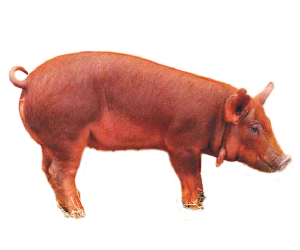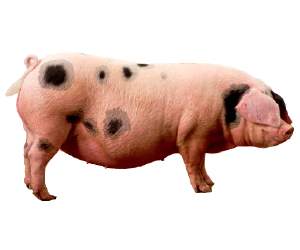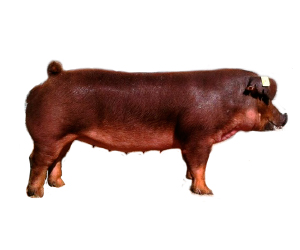Heritage BREEDS
We only use antibiotic-free, heritage breed American pigs, raised on pasture using traditional methods. Our animals are healthy and happy, the very best of old-world farming here in America.
We are very proud of the heritage breeds, and of our fantastic farmers who work so hard to keep these breeds — some of them very rare — viable and available so that I can bring them to you, with love and respect, revitalizing the methods the original craftsman in my family have passed on to me.
Each breed is distinct, with superior genetics and subtle differences in flavor, but they are all 100 percent happy and healthy heritage breeds. These are our favorites, followed by an introduction to our farmers, who are true American heroes, the backbone of this great tradition, and the reason I am able to bring you the best salame and prosciutto you have ever tasted.
BERKSHIRE
Yielding brighter pork than most, and featuring a thick, delicious fat cap, Berkshire meat is exceptionally flavorful. Historically the favorite breed of the English royalty, Berkshire pork is reddish/pink in color, balanced, porky and distinctive — often with hints of black pepper and mushroom. The characteristic intramuscular fat that runs through Berkshire meat gives it a smooth texture and melt on the tongue tenderness. Berkshire is the consistent pork of choice for many of the world’s best chef, and because it’s flavor and texture is so well balanced it’s a perennial favorite for every type of ham or salame.
Red Wattle
The Red Wattle was the first breed of pig sourced by our partners at Heritage Foods USA. The Red Wattle was once thought to be extinct, but a wild herd was found in Texas in the 1970s and select farmers have begun breeding them again in small numbers. Currently there are fewer than 1000 registered Red Wattle hogs registered in the United States, and it remains prized for its tender meat and splendid hams.
The Red Wattle is believed to have come to America’s shores in the mid 1700s from New Caledonia, where it populated the backyards of New Orleans’ homes. During the 18th and 19th centuries the locals bred Red Wattles to stand up to the Cajun cuisine. Red Wattle pork is juicy and well marbled, earthy, with a unique beefy robustness with notes of Cinnamon and Spice, that are not easily overwhelmed, making it ideal for strong old-world style salame. Its expressive taste is concentrated and bold.
Gloucestershire Old SpoT
Developed in England, the Gloucestershire Old Spot is a threatened British breed. Nicknamed “orchard pig”, these white pigs with big black spots were developed on fruit orchards, where they gorged themselves on fallen fruit and other treats. Their backyard grazing lifestyles led to the development of their oversized floppy ears, which protect their eyes during foraging and enhance their sense of smell. While this makes the Old Spot excellent foragers the negative impact on their peripheral vision causes the breed to be especially dependent on humans for protection from predators.
Old Spots became rare after World War II, when the shift to intensive pig production reduced interest in outdoor pigs. The breed almost became extinct in the 1960s but is experiencing a renaissance. Their lazy and gluttonous lifestyle yields pork that is fatty, delicious and succulent.
Tamworth
The Tamworth hog is another threatened Heritage breed with fewer than 1000 registered in the United States. Traditionally known as the best "bacon hog”, Tamworths are a thrifty, hardy breed, originating in Ireland, generally larger in size with lean athletic builds. They are known for being a great "dual purpose" pig, producing both stunningly good pork and exceptional bacon. The pig's long angular snout makes it an excellent forager, prized by chefs for its incredible tenderness and clean, sweet porky flavor with subtle notes of minerals and fruit.
Thought to have descended from wild boars via native pig stock of Europe, Tamworths still maintain many "unimproved" traits. When crossed with wild hogs, Tams are known to sometimes produce striped "Iron Age" piglets, similar to those kept in early domestication. The Royal Agricultural Society first recognized the Tamworth in 1885.
Duroc
The Duroc is an older breed of American domestic pig that has become one of the most popular breeds because of its great taste and strong, favorable genetics, but pure Duroc is very hard to find. Duroc meat is crisp and clean — known for great marbling, excellent spareribs and juicy shoulder roasts. Its taste and texture are polished and clean on the palate.
Durocs are a red pig strain developed around 1800 in New England and reputed to trace their ancestry back to the early red pigs first brought over by Columbus and DeSoto from the Guinea coast of Africa. Durocs are especially valued by farmers for their hardiness and quick but thorough muscle growth.
Large Black
Like the Gloucestershire Old Spot the Large Black was developed in backyards and on pasture in Cornwall, Devon, and Somerset, England. Originally know as the Lop Eared Black, the breed was selected for large size and ability to thrive on grazing alone. Its characteristic floppy ears shield its eyes while rooting in the dirt and its dark skin protects it from sunburns during long hours on pasture.
The Large Black gained rapid popularity during the last half of the 1800s, becoming one of the most popular English pig breeds by 1920. The decline in interest for outdoor production pigs after World War II caused the breed to become nearly extinct by 1960.
Today, with increased interest in pasture-raised pork, the Large Black is experiencing a renaissance. While this breed remains very rare — with less than 1000 registered in the United States - its large size, good fat development, and excellent foraging ability has made it popular among farmers and charcutiers. It’s taste is described as Firm, Sweet & Savory, Exquisite, and Delicate.






